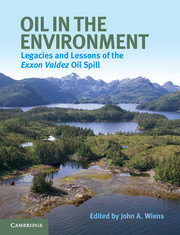Book contents
- Frontmatter
- Contents
- List of contributors
- Use of acronyms
- Acknowledgments
- A bibliographic note
- Prologue
- Part I Introduction and background
- Part II Oil in the environment
- Part III Biological effects
- 9 Cytochrome P450 1A (CYP1A) as a biomarker in oil spill assessments
- 10 Assessing effects and recovery from environmental accidents
- 11 Shoreline biota
- 12 Oiling effects on pink salmon
- 13 Pacific herring
- 14 Oil and marine birds in a variable environment
- 15 Sea otters: trying to see the forest for the trees since the Exxon Valdez
- Part IV Assessing oil spill effects and ecological recovery
- Part V Conclusions
- Index
- References
11 - Shoreline biota
Published online by Cambridge University Press: 05 July 2013
- Frontmatter
- Contents
- List of contributors
- Use of acronyms
- Acknowledgments
- A bibliographic note
- Prologue
- Part I Introduction and background
- Part II Oil in the environment
- Part III Biological effects
- 9 Cytochrome P450 1A (CYP1A) as a biomarker in oil spill assessments
- 10 Assessing effects and recovery from environmental accidents
- 11 Shoreline biota
- 12 Oiling effects on pink salmon
- 13 Pacific herring
- 14 Oil and marine birds in a variable environment
- 15 Sea otters: trying to see the forest for the trees since the Exxon Valdez
- Part IV Assessing oil spill effects and ecological recovery
- Part V Conclusions
- Index
- References
Summary
Introduction
Coastal shorelines teem with life. The intersection of the land with the sea, combined with tidal fluctuations and coastal currents, creates an array of habitats that supports an amazing diversity of plants and animals – limpets, starfish, anemones, crabs, rockweed, eelgrass, snails, tubeworms, and the like – that live on the surface and in the sediments of the intertidal zone. When floating oil from a marine oil spill strikes a shoreline, the potential effects on these organisms (the shoreline biota) may be severe. Even species that are not directly affected by spill may suffer its effects if the shoreline prey on which they feed are diminished. Understanding how a spill affects the shoreline biota is therefore important to assessing the potential effects on the broader shoreline and coastal ecosystems.
During the Exxon Valdez spill, oil first spread over shorelines in Prince William Sound (PWS) and later extended outside of PWS to the Kenai Peninsula, Kodiak Island, and Alaska Peninsula (see Map 1, p. v). The effects of the spill and the need to respond rapidly were of enormous concern, particularly within PWS, where oil quantities and potential toxicity were greatest. In this chapter, we discuss three major programs undertaken to assess the effects of the Exxon Valdez oil spill on shoreline biota in PWS, including studies to determine the effects of intensive cleanup efforts.
- Type
- Chapter
- Information
- Oil in the EnvironmentLegacies and Lessons of the Exxon Valdez Oil Spill, pp. 241 - 262Publisher: Cambridge University PressPrint publication year: 2013
References
- 1
- Cited by

